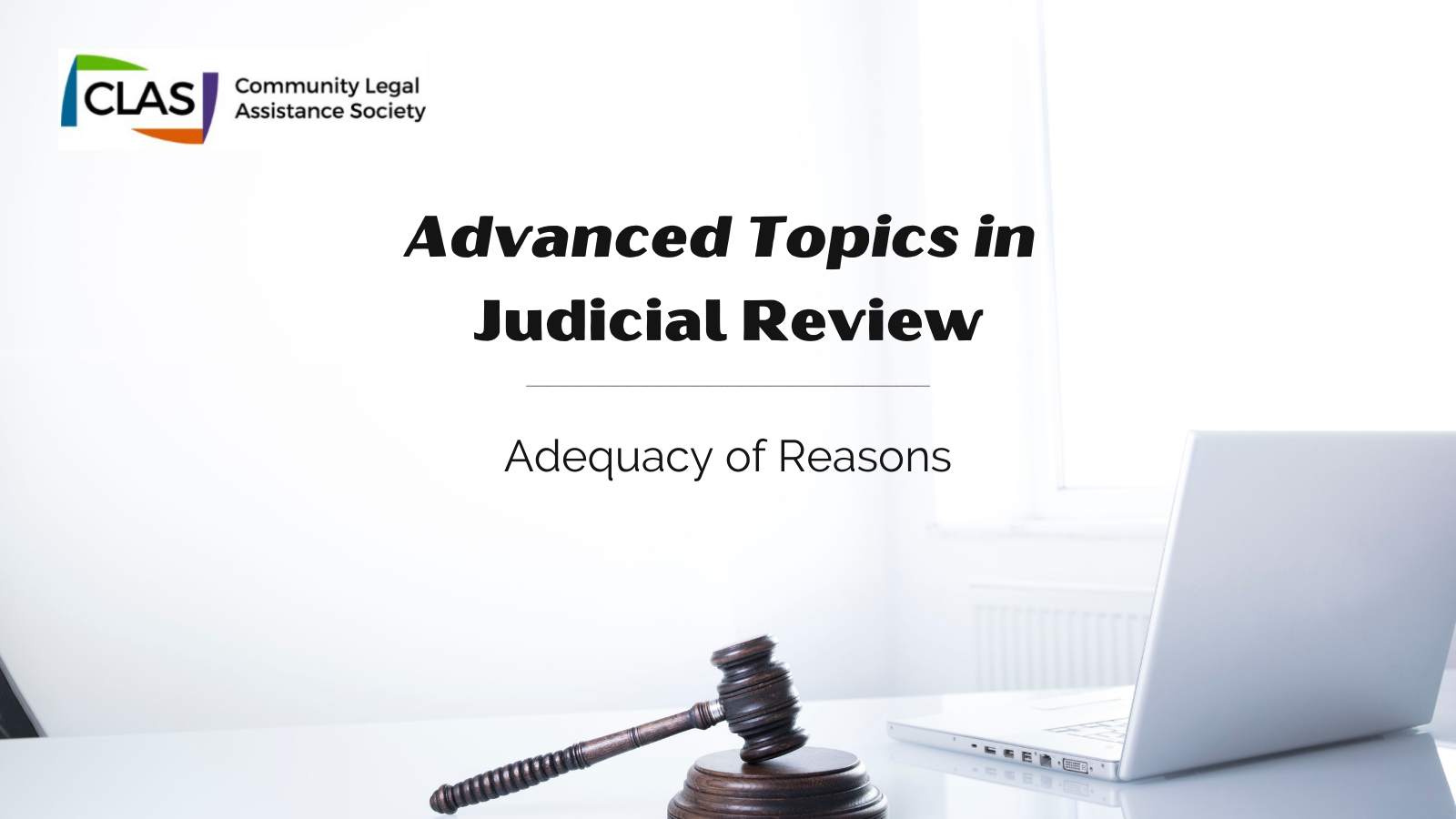In this series, we build on the foundations of our “Intro to Judicial Review” series to learn more about the issues arise in judicial reviews.
By Isaac Won, Community Law Program Lawyer
Introduction
When an administrative tribunal decides a case, it usually must provide the parties with written reasons that explain the decision. The idea behind this requirement is that parties should be able to know why the tribunal ruled the way it did. Written reasons are particularly important for the loser of the case, so that they can know why they were unsuccessful and file for judicial review or appeal if the reasons show that the tribunal made an error.
Courts have placed more scrutiny on the written reasons of decision-makers in recent years, to the point that a party that is unhappy with the decision can apply for judicial review on the basis that the reasons given are inadequate[1], or do not properly explain why and how the decision was made.
What do inadequate reasons look like?
When it comes to adequacy of reasons in the residential tenancy setting, a good case to know is Laverdure v. First United Church Social Housing Society[2]. Laverdure is a BC Supreme Court case where the judge considered whether the RTB officer’s reasons for the decision in that case were adequate. In his decision, the judge described what an RTB officer’s reasons for decision must contain in order to be adequate. The reasons must:
- Set out the legal test for the claim being put forward by the party making it;
- Set out the officer’s findings of fact and the evidence they relied on to reach those findings; and
- Apply the findings of fact to the test to reach a conclusion that can be understood by the parties and a reviewing court, if necessary.
Other useful cases to review include Hawk v Nazareth[3] and Collard v. British Columbia (Residential Tenancy Act Dispute Resolution Officer)[4].
Past court cases tell us that for reasons to be adequate, the decision-maker must set out their findings of fact and the evidence used to make those findings. It is not sufficient for a decision to simply recite the submissions and evidence of the two parties and then state a conclusion. If an administrative tribunal’s reasons do not do this, or do not comply with the Laverdure criteria, this may constitute a patently unreasonable error resulting in a judge overturning the decision and sending it back to the decision-maker to be redone.
However, it is important to keep in mind that these requirements only apply to the central issues and concerns in the case. Minor issues that would not affect the ultimate outcome of the case generally do not attract the same adequacy requirements. For this reason, it is usually wise to allege inadequacy of reasons with regard to specific, important issues in the decision instead of making a broad allegation that the decision is overall inadequate.
Examples of inadequate reasons
There are several cases where a decision-maker’s reasons were found to be inadequate that can be helpful to review. Laverdure, the case discussed above, also provides a good demonstration of a decision-maker failing to meet the required standard for adequate reasons. In Laverdure, the RTB arbitrator:
- failed to correctly state the test the landlord had to meet to justify their eviction;
- failed to explain what evidence was sufficient to satisfy the landlord’s legal test;
- stated that the landlord’s evidence was preferred over the tenant’s, but without explaining why; and
- failed to address the most significant issue raised by the parties.
Marshall v Pohl[5] is another case that was set aside on the grounds of inadequate reasons. The RTB arbitrator ruled in the landlord’s favour by finding that the “multiple incidents” involving the tenant had occurred, resulting in other occupants of the tenant’s building being unreasonably disturbed. On judicial review, the judge overturned the decision because the arbitrator:
- made no findings of fact about which of the “multiple incidents” occurred;
- did not address the tenant’s explanation and denial of some of the incidents or explain why the landlord’s evidence was preferred over the tenant’s; and
- did not explain which incident (or incidents) met the required standard of “significant interference” or “unreasonable disturbance”.
Shahcheraghi v. Divangahi[6] resulted in yet another RTB decision being set aside for inadequate reasons. In that case, the judge overturned the decision because the arbitrator:
- did not address or even mention highly relevant evidence contrary to the decision;
- made an award for an amount of unpaid rent that was different from that suggested by either side, with no explanation of how it was calculated; and
- failed to address legal arguments about whether the landlord had to pay the tenant double the security deposit amount.
Conclusion
While “adequate” reasons do not ultimately require much of a decision-maker, it is important to understand what a party is entitled to receive as justification for a decision made in their case. By providing adequate reasons, a decision-maker demonstrates to the parties the reasoning and basis for the decision made. Flaws in the reasons can be a reviewable error on their own or can indicate other deficiencies in the decision with the potential to justify judicial review.
If you’d like to learn more about how to do your own judicial review, please visit judicialreviewbc.ca. If you need legal advice about filing for judicial review, please see our Get Legal Help page to see if CLAS can assist you.
[1] Canada (Minister of Citizenship and Immigration) v. Vavilov, 2019 SCC 65 at para. 17; Air Canada v. British Columbia (Workers’ Compensation Appeal Tribunal), 2018 BCCA 387 at para. 74
[2] 2014 BCSC 2232 (CanLII)
[3] 2012 BCSC 211 (CanLII)
[4] 2011 BCSC 136 (CanLII)
[5] 2019 BCSC 406 (CanLII)
[6] 2021 BCSC 1576 (CanLII)

